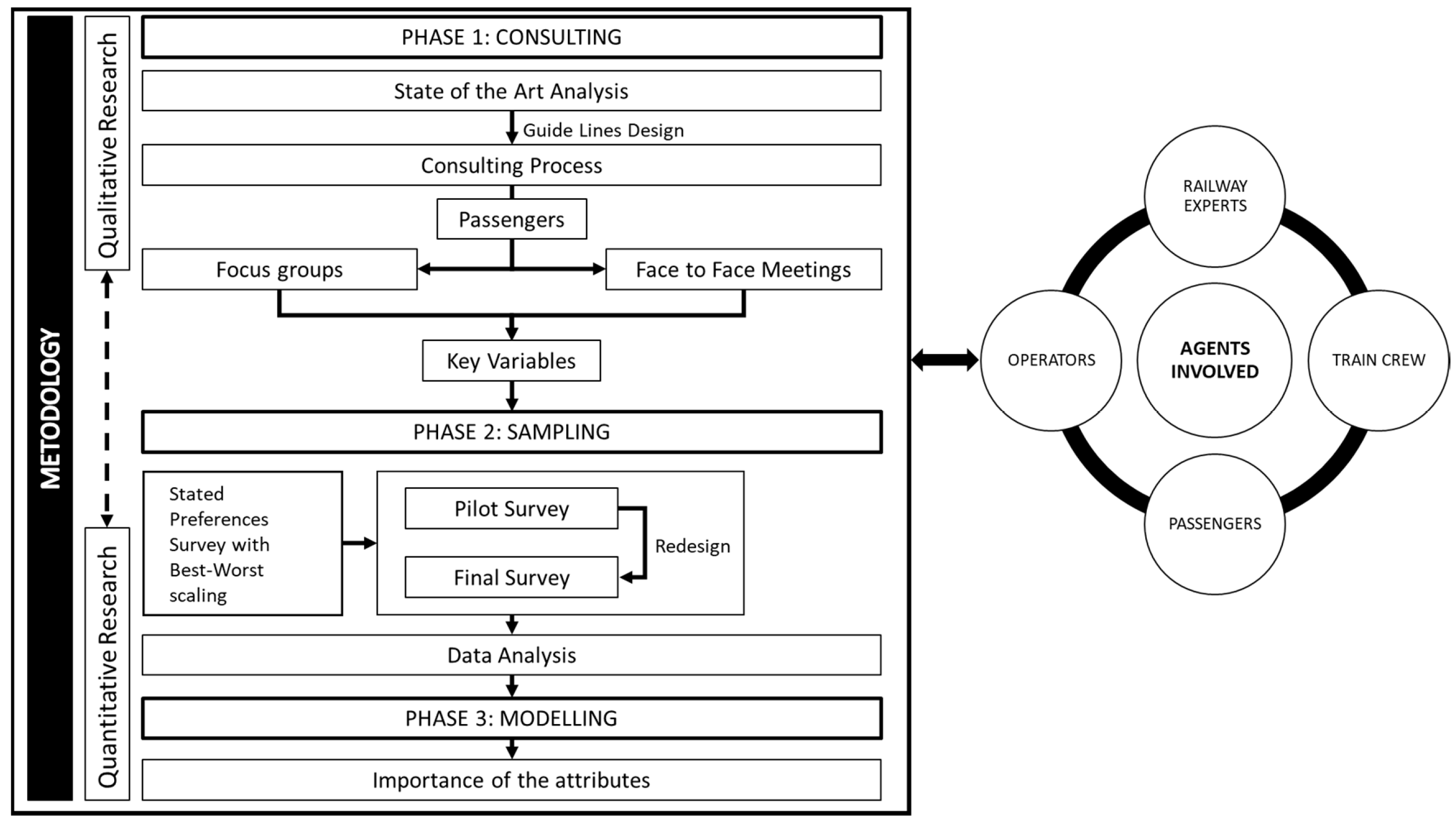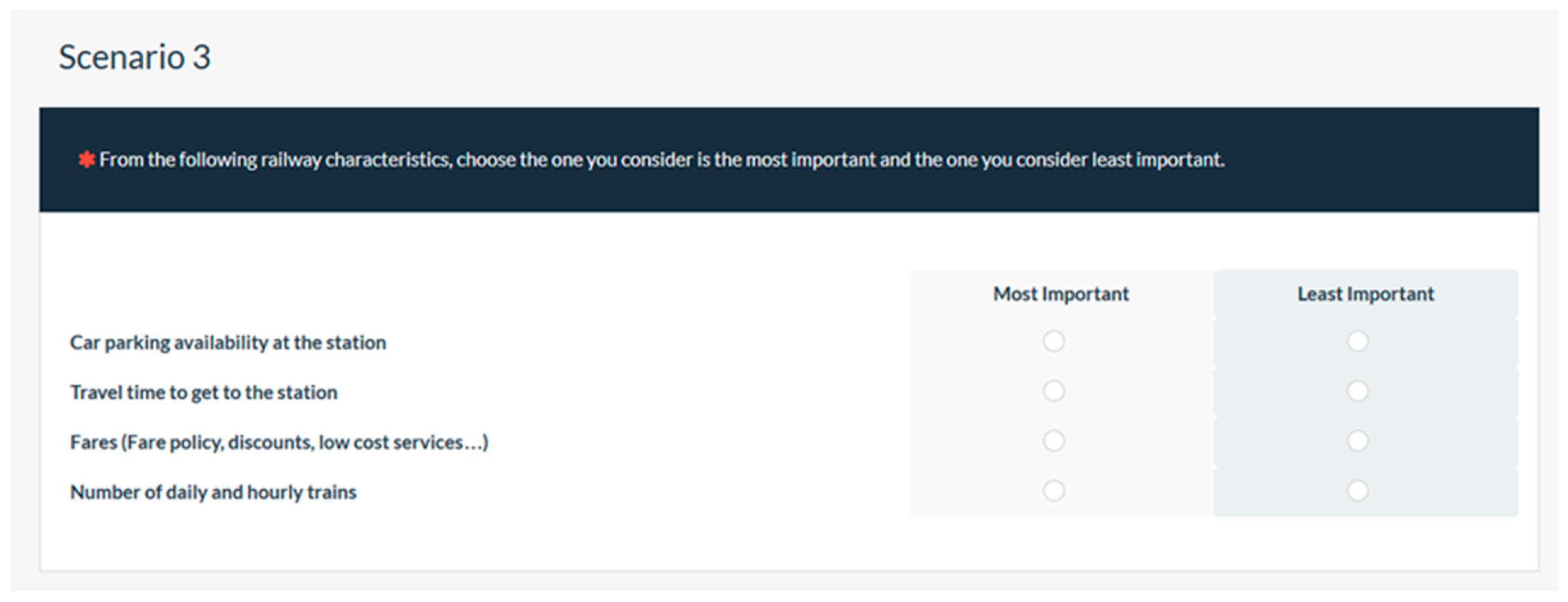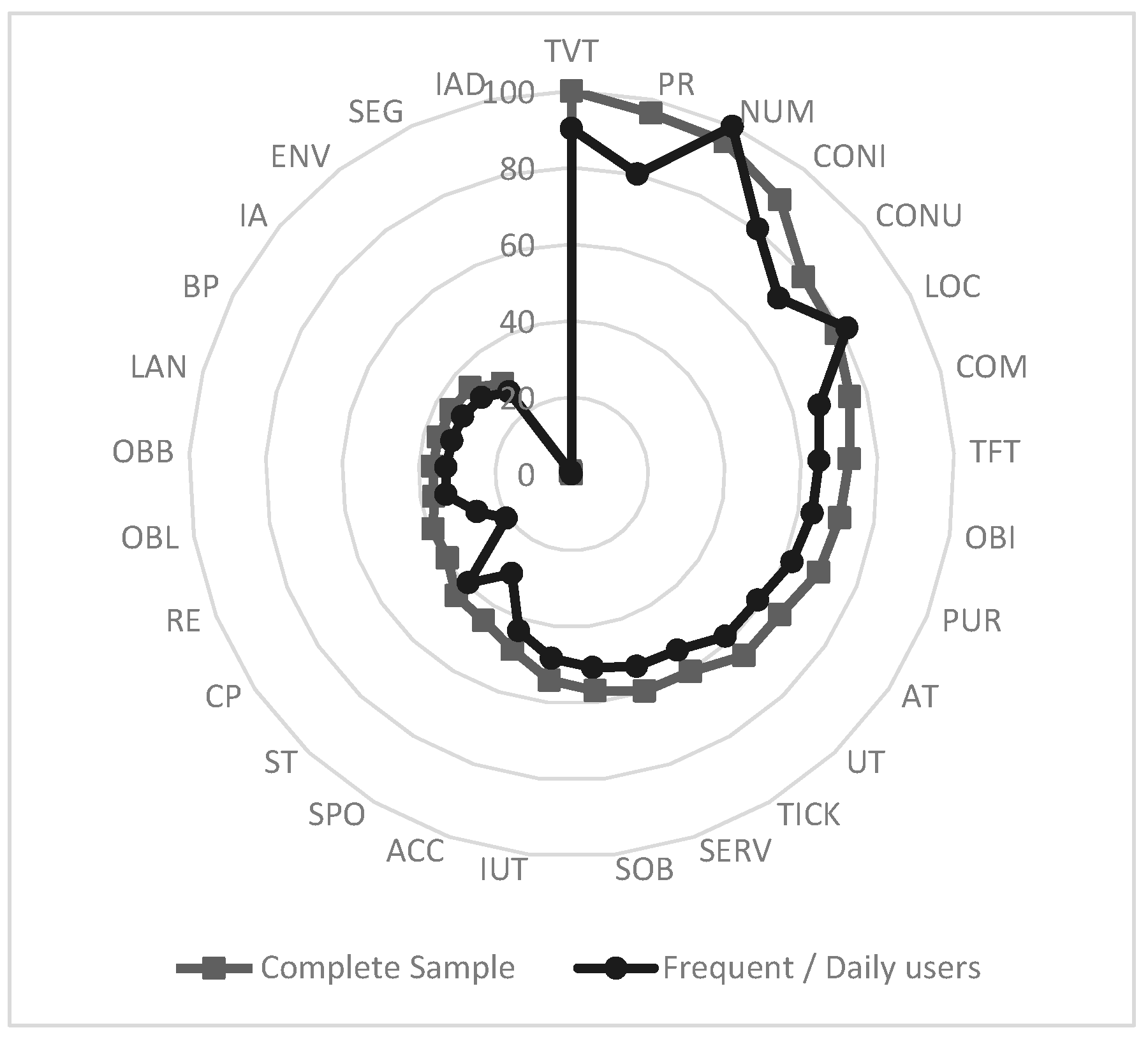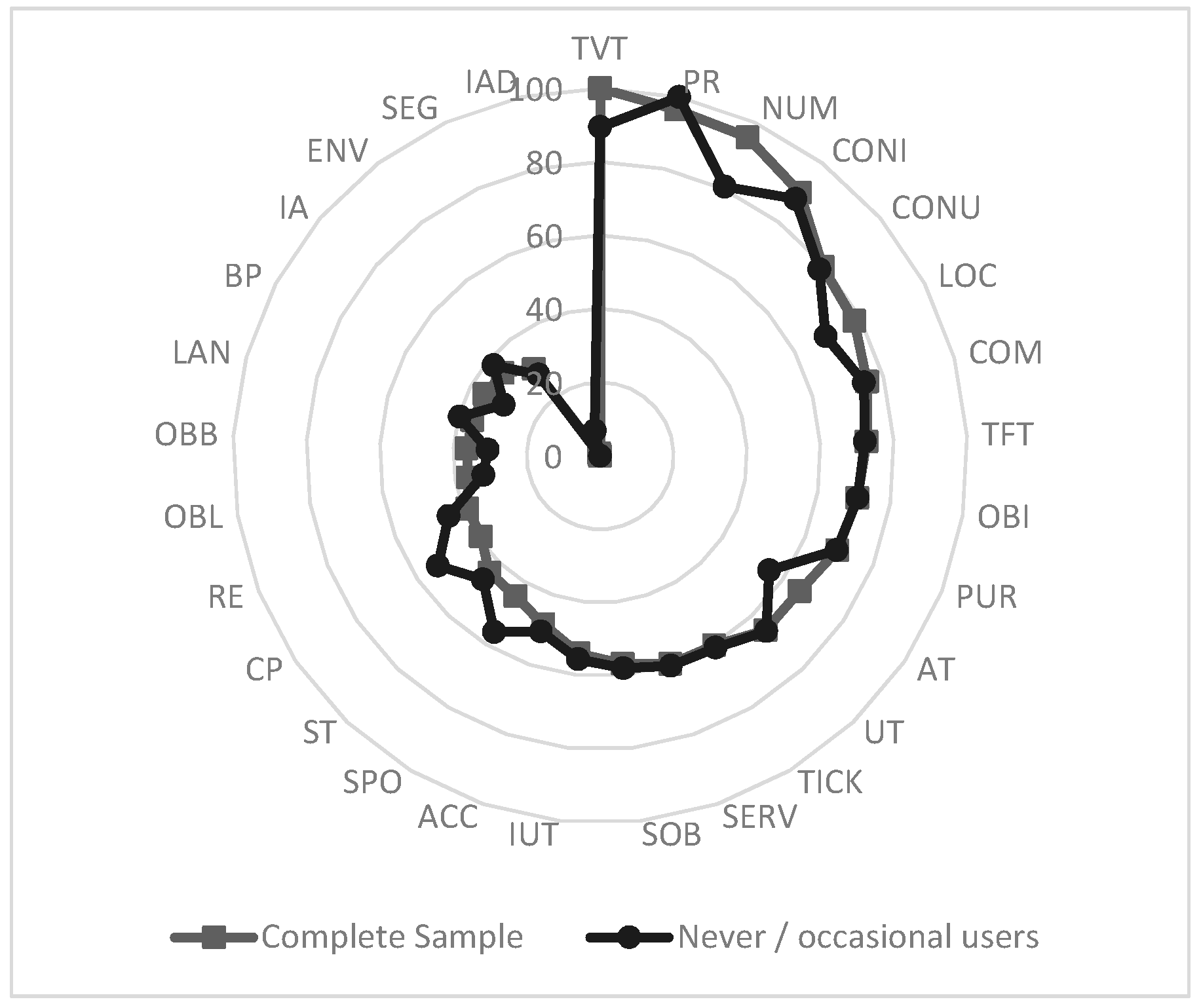Based on the information obtained in the qualitative research phase, in this section, we proceeded to design the SP survey. The later analysis and modelling of the gathered data allows to order the attributes according to their importance.
3.3.1. Survey Design
The final survey carried out by transport users consisted of four sections. In the first one, a general introduction was presented, explaining the main objectives of the study. In section two, the respondents were asked about their sociodemographic characteristics (gender, age, city of residence, possession of driving license, if they suffer from reduced mobility or not, work status, and income level). In the third section, information was asked about railway use: frequency of use, distance to the nearest station, modes used to get to and from the stations, mode of transport most commonly used, and in case of not using the train, the reason not to do so.
The last section of the survey corresponds to the SP scenarios. Given that a complete ranking of the 30 attributes obtained in qualitative research would require a lot of cognitive effort for the respondents, the SP methodology allowed them to compare only 4 attributes each time. In each SP scenario, the respondent decided which one of the four attributes was the most important attribute (Best option) and which one was the least important (Worst option). This kind of choice is commonly known as BW. The efficient experimental design obtained after carrying out the pilot survey with the minimum D-Error can be consulted in
Table 4. The design was divided into 6 blocks; that is, each respondent had to answer only one block consisting of 5 BW scenarios, choosing through 4 attributes in each.
The survey was conducted through an online platform in order to obtain greater heterogeneity in the responses and to have a much wider sample.
Figure 2 shows an example of a BW choice scenario between four attributes.
3.3.3. Modelling
With the BW data collected, an MNL model has been specified, which allows the establishment of the order of importance of the attributes based on the coefficient estimated. The higher the coefficient of an attribute, the greater the importance that respondents have given to it. For the model to be estimable, it is necessary to establish an attribute as a base, to which the coefficient value of 0 is given. In this case, the attribute OBP (Possibility of carrying pets on board) was chosen given that it was considered the least important. Hence, the coefficients of all the remaining attributes will have positive values.
Table 6 shows the parameters estimated.
The difference between the values of the parameters is associated with how much an attribute is more important compared to another. To make it easier to understand, the coefficients have been normalized with values between 0 and 100, giving the value 100 to the highest coefficient (TVT) and 0 to the lowest (OBP).
Figure 3 shows the result of that normalization, ordering the attributes from the most important to the least important.
The most important attribute turned out to be the travel time (TVT), followed closely by the price (PR) and frequency of services (NUM). In a second level are the attributes associated with accessibility to railway service, considering both interurban and urban connections of the stations (CONI and CONU, respectively) and the good location of these (LOC), often near city centres.
The least important attributes turned out to be those attributes that are very specific and purely additional services, such as the segregation of the service in different classes (SEG), the information about activities at the destination (IAD), and the possibility of taking pets on board (OBP). Furthermore, it can be seen that there is a considerable difference between these three less important attributes and the group of immediately important attributes, where the respondents grant a level of relevance more or less similar to a set of 7 attributes related to additional rail services: Seat reservation (RE), possibility of carrying luggage with no weight limitation (OBL), possibility of carrying bikes on board (OBB), information and services available in multiple languages (LAN), bicycle parking availability at the station (BP), information to access the station (IA), and the environmental policy of the company (ENV).
Another way to analyse the results is to perform the Best minus Worst operation. That is, subtract the number of times an attribute has been chosen as the least important option to the number of times it has been chosen as the most important one. In
Figure 4, it can be seen that there is a clear correlation between the Best minus Worst operation and the parameters obtained by the MNL Model with an R
2 = 0.94. This method was used to analyse the attributes in a grouped form, according to the classification defined in
Table 3.
Figure 5 shows the level of importance given to each one of the six groups. The groups are defined by three data: (i) the maximum Best minus Worst value (best rated attribute within the group), (ii) the minimum Best minus Worst values (worst rated attribute), and (iii) the average value of Best minus Worst of all the attributes within each group. A group that has a high Best minus Worst average shows that the attributes that are part of that group are very important for users. In contrast, the maximum and minimum values give a view of the dispersion on the importance of the attributes within each group.
The fare and the fare policy in general turned out to be the most important group of attributes. However, although the price of the trip is the most important attribute, a competitive price must be accompanied by a good ticket purchasing system with the possibility of using different types of tickets such as physical, electronic, and preferably combined with other modes of transport.
The attributes belonging to total travel time also showed to be very important for users. In addition, even though the level of importance changes, all the times associated with a trip are important for the user. Therefore, any effort to avoid wasted time along the full journey will have a very positive effect on the perception of the transport users. The only time attribute that was not important for the respondents was the duration of the security controls, probably because the time used for these purposes increases the security sensation of the users that see the controls as necessary.
Intermodality was considered important when combining with other public transport systems, while car parking at stations are not really important for users. Having parking space for bicycles is less important than being able to take the bicycle on the train, so it can be said that the people who make a trip combining the bicycle and railway prefer to travel taking the bike with them inside the train, instead of, for example, taking a public bicycle for the first and last miles.
In the case of information, the respondents consider information regarding the connections of the stations with other public transport systems and information on-board important, while the possibility of having information in several languages and information about the activities available at the destination received very low scores.
The comfort and auxiliary services are generally considered quite insignificant. The only attributes associated with this group that are considered important are on-board comfort and on-board safety against accidents. The rest, although different in level, are initially not significantly important for users.
Finally, the environmental policy is not considered too important for the overall population, although certain segments of the population can show greater interest in this aspect.
Therefore, it can be said that the desired service for transport users consists of a railway system with competitive prices and travel times. In addition, the railway must be comfortable and well-connected with other transport modes, especially with public ones, and users must have all this information easily accessible and clearly explained in all possible points and sources (stations, on-board, mobile, etc.). Once those needs are met, investing efforts can focus on other types of additional services that complement the passenger’s trip.
The socioeconomic variables obtained in the survey have allowed an analysis considering different types of user to be carried out. The most interesting results are those related with railway usage levels since they allow the differentiation of the importance given to the attributes by railway users and nonusers. For modelling, the different usage levels have been coded using the effect coding technique. Unlike dummy coding, in this type of coding, the reference group is identified by a −1 value. Therefore, the constant term obtained in the model represents the grand mean of the importance of each attribute for the sample as a whole. Thus, the coefficients associated with each level show the deviation of that group from the mean. The advantage of this type of coding is that it is possible to calculate the coefficient associated with the reference group. The value of this coefficient is calculated as the sum of the negative values of the coefficients of the rest of the groups. The effect coded variables have been introduced in the model as interactions with each attribute. Occasional/nonuser group have been defined as the base group.
Table 7 shows the estimated model, where those interactions that have turned out not to be statistically significant have been omitted.
The model coefficients show the differences of each group for every particular attribute. In order to facilitate the visualization, the following graphs (
Figure 6,
Figure 7 and
Figure 8) show the comparisons of each group with respect to the model estimated with the complete sample (
Table 6). The graphs are sorted from highest to lowest frequency of railway use.
The main difference between frequent users and the rest (
Figure 6) is the clear reduction in the importance of ticket prices (attribute PR). In the same way, the travel time slightly reduces its importance, while the service frequency becomes the most important variable. In terms of accessibility and connections with other means of transport, whether urban or interurban, the importance is slightly more reduce, while the location of stations becomes more important. At the bottom of the list, there is a clear reduction in the importance associated with police security, the availability of car parking at stations, and the reservation of seats. Through these variations, we can deduce that regular rail users are those that use the railway for daily commuting. Therefore, the importance of the attributes focuses mainly on having a good frequency of services and that the stations are accessible to their origins and/or destinations.
Users who use the rail weekly (
Figure 7) show a clear preference for total journey time, i.e., travel time by train and access time to it. In relation to additional services, a greater importance is observed for services related to intermodality with cycling and the possibility of carrying large volume luggage on board. We can include in this group those people who make their daily trips usually by bicycle but who combine it with the railway for different reasons such as a longer travel distance. On the other hand, this group can also include those people who make medium long-distance journeys and who choose the railway if it is competitive with the other modes in terms of travel and access time.
Finally, for those people who never or hardly ever use the railway (
Figure 8), the price takes the greatest importance. In addition, the frequency, the location of the stations, and the access time considerably reduce their importance. In contrast, urban and interurban connections with other means of transport and the availability of car parking at the stations (CP) increase their importance. Additional services focused on unusual users are also considered more important, such as the availability of information in different languages, information to access stations, or information of activities at the destination. Within this group, we can include passengers who use the railway if it is economically better than the rest of the alternatives. In addition, these users appreciate the additional services that provide access to the necessary information of the service.














